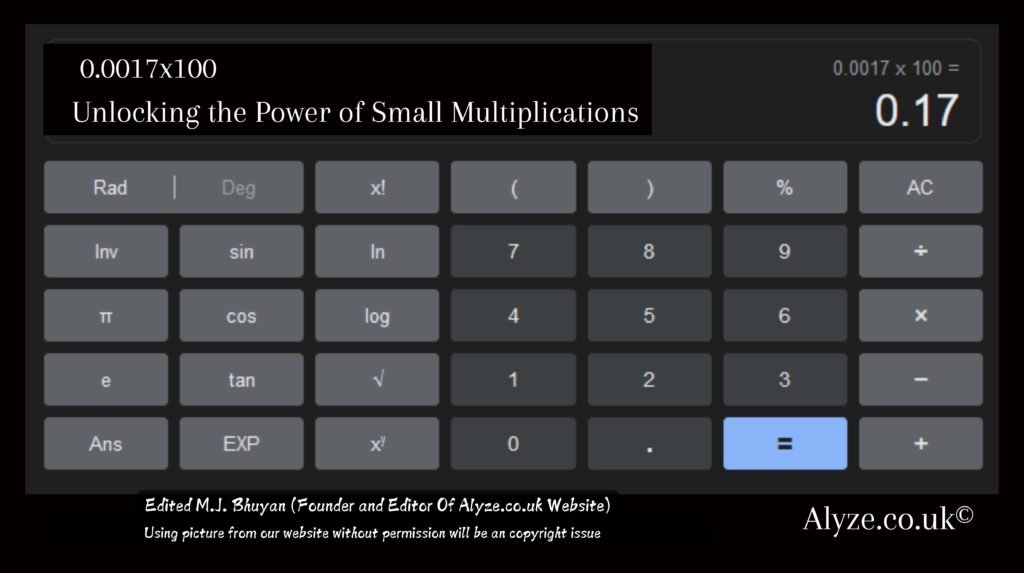Introduction
0.0017×100 : Small figures, for example 0.0017, are not always considered important, but indeed they bear much significance in our day-to-day lives, be that in the financial field, science, or businesses. This paper will respond to what one gets in multiplying 0.0017 by 100, the importance of the answer, and how that simple multiplication unfolds in real life. Small numbers will have meaning for you.
Also Read : Salta La Coda Biglietto D’Ingresso Oscuro Alla Grotte De Baume : Unveiling the Mysteries
Understanding 0.0017×100
0.0017 by 100 is a simple task of multiplication. The results will be 0.17. In its simplicity, it finds application in a number of ways.
Ways to Multiply Decimals
So, multiplying decimals is easy once you know how many places to move the decimal point. Here is how it works for 0.0017×100
Step 1: Look at the number 0.0017. There are four digits to the right of the decimal.
Step 2: When we multiply by 100 we move the decimal two places to the right.
Step 3: Answer is 0.17.
Use of 0.0017×100
Finance: Manipulating Money with Precision
In finance, small quantities like 0.0017 are invoked all the time. Suppose we multiply this number by 100 and get 0.17, now this is a number that one can relate to and use.
Interest Rates: This rate is something that banks use on their savings accounts, for example. When brought down to applying it to be multiplied by 100, it simply is made into 0.17%, but it is better perceived by the customer.
Profit Margins: Businesses face a profit margin as low as 0.0017. This, when multiplied by 100, becomes 0.17%, and now it is better perceived by the viewer about the profit made through that product.
Science: Precision in Experiments
Scientists very often deal with very small figures. Therefore, multiplying 0.0017 by 100 helps to change such a small figure into a more practical figure.
Chemical Solutions: In chemistry, a solution may be 0.0017 Molar (M). Multiplying that by 100 would make it 0.17 M, which would easily work in experiments.
Physics Measurements: In physics, very small values like 0.0017 might have applications in forces or speeds. If multiplied by 100, this might be more practical in experiments.
Data Analysis: Making Sense of Numbers
The data analyst uses small figures in his work. It might be easier to understand by multiplying 0.0017 with 100.
Data Normalization: Sometimes for large data sets, the analysts multiply small numbers like 0.0017 to 0.17 by 100 in order to compare or analyze the data.
Machine Learning: In machine learning, generally, it is a practice to multiply such small numbers by 100 to boost the performances of the models. For instance, often 0.0017 would be multiplied by 100 for appropriate models.
Uses of 0.0017×100 for Everyday Measurement
Healthcare: Correct Dosages
Accurate dosage with respect to medication is a critical area of healthcare. Thus, a small dose like 0.0017 grams may be multiplied by 100 to get 0.17 grams for easy measurement and dispensing of the said dose.
Environmental Science Measuring levels of Pollution
Environmental scientists measure the pollution amount; and often they would have a very low number like 0.0017 parts per million – then multiply it by 100 to get 0.17 ppm-for easier presentation and analysis.
Engineering: Structure with Accuracy
Engineers work with measurements that are accurate. A tolerance of 0.0017 millimeters may be multiplied by 100 to become 0.17 millimeters so that parts would fit together.
Conclusion
Really, it may seem easy to multiply 0.0017 by 100, but in fact, this contains a colossal effect toward most variables: in finance and in science, this will enable professionals to work more and much more flexibly on small numbers. You can begin to appreciate exactly how and why this multiplication is used in everyday life and various industries. See More…



